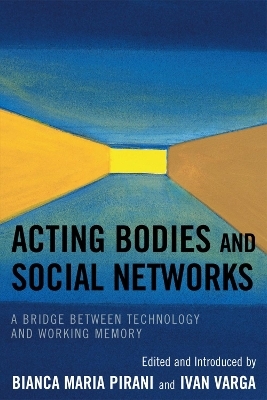
Acting Bodies and Social Networks
University Press of America (Verlag)
978-0-7618-4997-1 (ISBN)
Acting Bodies and Social Networks analyzes the complex interactions of body, mind and microelectronic technologies. Internationally renowned scholars look into the nature of the mind - a combination of thought, perception, emotion, will and imagination - as well as the ever-increasing impact and complexity of microelectronic technologies. The proliferation of these technologies facilitates a profound change in the boundaries between bodies and technologies. These technologies expand the temporal and spatial existence of humans; today, people can instantly communicate all over the world and overcome time and space restraints by using the latest available microelectronic technologies. The first volume, The Body as Social Icon, examines how memory is affected by the new technology and the related theoretical issues while the second, Mapping Bodies in a Networked Space, deals with the influence of the new technologies on everyday life practices. At the "information portal," the brain's capacity is loosing its ability to retain information. In 2004, a number of well known neuroscientists, including Nobel laureate Eric Kandel, wrote a review about the ethical dilemma computer technologies raise, stating that "humanity's ability to alter its own brain function might well shape history as powerfully as the development of metallurgy in the Iron Age." By introducing the concept of acting body, this book contributes to discussion concerning the future development of Homo sapiens. We consider the acting body as a bridge between technology and working memory, which entails a radical change in our approach to the social sciences.
Bianca Maria Pirani professor of sociology of cultural and communicative processes at Sapienza, University of Rome, is president of Research Committee 54, "The Body in the Social Sciences," of the International Sociological Association. She is an editorial board member of Sage Studies in International Sociology. Pirani has published widely on the relations between human bodies and social knowledge as editor of the monograph Bodily Order. Mind, Emotion and Social Memory, "Current Sociology" (March 2005, Sage publication), and co-editor with Ivan Varga of the book The New Boundaries between Bodies and Technologies. Ivan Varga is professor emeritus of sociology, Queen's University, Canada and honorary president of Research Committee 22 "Sociology of Religion" of the International Sociological Association. Varga is a member of the editorial board of International Sociology.
Chapter 1 Foreword Chapter 2 Introduction Chapter 3 1. Utopian Bodies Chapter 4 2. Obama as Charismatic Icon Chapter 5 3. A Social Icon: the "Squart" Chapter 6 4. Philosophy as Memory Chapter 7 5. Icons, Symbols, Cultures Chapter 8 6. Increasing Diversity in a Changing Europe Part 9 Second Part: Social Icons of the Body: Empirical Case-studies Chapter 10 7. The Play Actors: Fleeing Bodies, Remaining Prudishness or...Body under control? Chapter 11 8. Body Cult and Consumption: Fashion and Beauty in the Construction of Lifestyles Chapter 12 9. Because also I Am Worthy: the Male Body on the Stage Chapter 13 10. Spectacular Boobs. An in-depth look at Sex-themed Restaurants and their Female Waitresses Chapter 14 11. Southern Bodies: Bodies, Gender and Sexuality in World Society Chapter 15 12. How Do I Change His Nappy? Disabled Mothers and Cyber-community Part 16 Volume Two: Mapping Bodies in Networked Space Part 17 First Part: The Body and its Prosthetics: Laboratories Chapter 18 1. . . . a body under the bushes: Ghosts in the Machine Chapter 19 2. About the Technological Bricoleur Chapter 20 3. Cyborg Identity and Contemporary Techno-utopias: Adaptations and Transformations of the Body in the Age of Nanotechnology Chapter 21 4. Body becoming architecture: A continuum for the body's interface with architecture through digital networks Chapter 22 5. Resistances of the Body. The Presence of the Human Body in the Automated World Chapter 23 6. Social Bodies and Locative Technologies Part 24 Second Part: Technology, Physiology and Memory Chapter 25 Neurosociological Foundations of Social Networks: Distress-dependent Synaptic Architecture in Social Systems Chapter 26 Technology, Memory and the (Mind) Body:Towards the Integration of the Biological and the Cultural in the Analysis of Human Social Behavior Chapter 27 Technology and the Body in Aboriginal Identity Making Chapter 28 Bodies in Canyoneering: an Essay on Socio-geographic Mapping Chapter 29 Bodies in Action: Performing Identity in Dating Sites Chapter 30 From the Developing Mind to Developing Technology Chapter 31 Postscript Chapter 32 About the contributors
| Verlagsort | Lanham, MD |
|---|---|
| Sprache | englisch |
| Maße | 155 x 233 mm |
| Gewicht | 653 g |
| Themenwelt | Sachbuch/Ratgeber ► Gesundheit / Leben / Psychologie |
| Sozialwissenschaften ► Kommunikation / Medien ► Kommunikationswissenschaft | |
| Sozialwissenschaften ► Soziologie | |
| ISBN-10 | 0-7618-4997-1 / 0761849971 |
| ISBN-13 | 978-0-7618-4997-1 / 9780761849971 |
| Zustand | Neuware |
| Haben Sie eine Frage zum Produkt? |
aus dem Bereich


